topology problem Prove that there is no open map from Sn to
Solution
Ans-
an open map is a function between two topological spaces which maps open sets to open sets.[1][2][3] That is, a function f : X Y is open if for any open set U in X, the image f(U) is open in Y. Likewise, a closed map is a function which maps closed sets to closed sets.[3][4] A map may be open, closed, both, or neither;[5] in particular, an open map need not be closed and vice versa.[6]
Open[7] and closed[8] maps are not necessarily continuous.[4] Further, continuity is independent of openness and closedness in the general case and a continuous function may have one, both, or neither property;[3] this fact remains true even if one restricts oneself to metric spaces.[9] Although their definitions seem more natural, open and closed maps are much less important than continuous maps. Recall that, by definition, a function f : X Y is continuous if the preimage of every open set of Y is open in X.[2] (Equivalently, if the preimage of every closed set of Y is closed in X).
Early study of open maps was pioneered by Simion Stoilow and Gordon Thomas Whyburn.[10]
Contents
[hide]
Examples[edit]
Every homeomorphism is open, closed, and continuous. In fact, a bijective continuous map is a homeomorphism if and only if it is open, or equivalently, if and only if it is closed.
If Y has the discrete topology (i.e. all subsets are open and closed) then every function f : X Y is both open and closed (but not necessarily continuous). For example, the floor function from R to Z is open and closed, but not continuous. This example shows that the image of a connected space under an open or closed map need not be connected.
Whenever we have a product of topological spaces X=Xi, the natural projections pi : X Xi are open[11][12] (as well as continuous). Since the projections of fiber bundles andcovering maps are locally natural projections of products, these are also open maps. Projections need not be closed however. Consider for instance the projection p1 : R2 R on the first component; A = {(x,1/x) : x0} is closed in R2, but p1(A) = R {0} is not closed. However, for compact Y, the projection X × Y X is closed. This is essentially the tube lemma.
To every point on the unit circle we can associate the angle of the positive x-axis with the ray connecting the point with the origin. This function from the unit circle to the half-openinterval [0,2) is bijective, open, and closed, but not continuous. It shows that the image of a compact space under an open or closed map need not be compact. Also note that if we consider this as a function from the unit circle to the real numbers, then it is neither open nor closed. Specifying the codomain is essential.
The function f : R R with f(x) = x2 is continuous and closed, but not open.
Properties[edit]
A function f : X Y is open if and only if for every x in X and every neighborhood U of x (however small), there exists a neighborhood V of f(x) such that V f(U).
It suffices to check openness on a basis for X. That is, a function f : X Y is open if and only if it maps basic open sets to open sets.
Open and closed maps can also be characterized by the interior and closure operators. Let f : X Y be a function. Then
The composition of two open maps is again open; the composition of two closed maps is again closed.[13][14]
The categorical sum of two open maps is open, or of two closed maps is closed.[14]
The categorical product of two open maps is open, however the categorical product of two closed maps need not be closed.[13][14]
A bijective map is open if and only if it is closed. The inverse of a bijective continuous map is a bijective open/closed map (and vice versa).
A surjective open map is not necessarily a closed map, and likewise a surjective closed map is not necessarily an open map.
Let f : X Y be a continuous map which is either open or closed. Then


 Homework Sourse
Homework Sourse